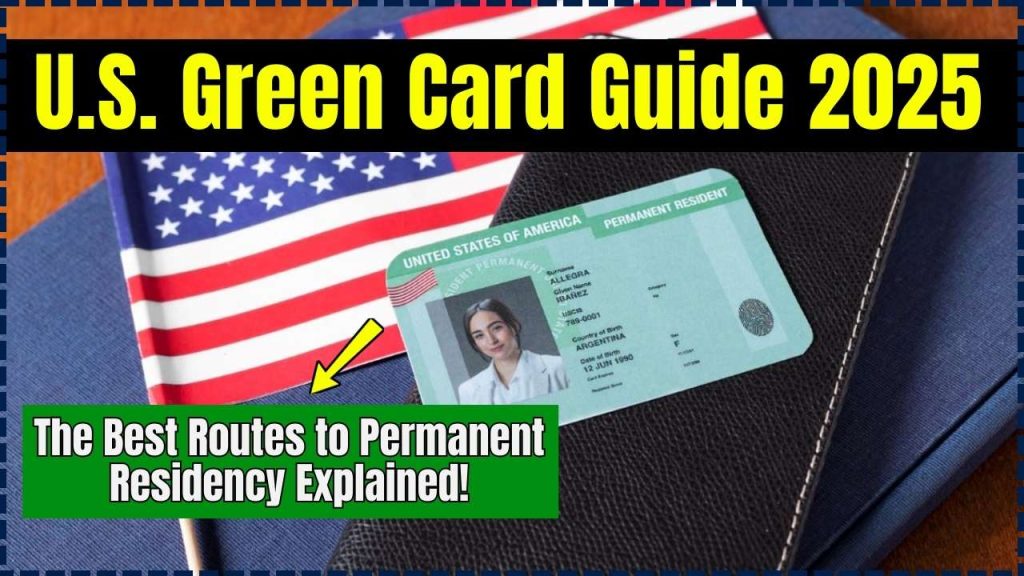
U.S. Green Card Guide 2025: Obtaining a U.S. Green Card is a significant step toward achieving permanent residency in the United States. In 2025, several pathways exist for individuals seeking to live and work permanently in the U.S. Understanding these options can help applicants navigate the complex U.S. immigration system efficiently.
This article breaks down the best routes to a U.S. Green Card in 2025, providing clear insights for professionals, families, investors, and other eligible applicants.
U.S. Green Card Guide 2025
| Key Information | Details |
|---|---|
| What is a Green Card? | A permit allowing non-U.S. citizens to live and work permanently in the U.S. |
| Primary Routes | Family-based, Employment-based, Investment-based, Diversity Visa Lottery, and Humanitarian programs. |
| Processing Times | Varies by category: Family-based (1-10 years), Employment-based (6 months to several years). |
| New Policy Changes | Introduction of a Gold Card Visa for investors paying $5 million. |
| Official Resources | USCIS.gov |
Navigating the U.S. Green Card process in 2025 requires understanding the available routes, eligibility requirements, and processing times. Whether you apply through family sponsorship, employment, investment, or the Diversity Visa Lottery, the journey can be complex, but with proper guidance, obtaining a Green Card is achievable.
1. Family-Based Green Cards
The family-based Green Card is one of the most common ways to obtain U.S. permanent residency. U.S. citizens and lawful permanent residents (LPRs) can sponsor family members under different preference categories:
Immediate Relatives of U.S. Citizens (No annual limit)
- Spouses
- Unmarried children under 21
- Parents of U.S. citizens (if the sponsor is over 21)
Family Preference Categories (Limited visas per year)
- F1: Unmarried adult children of U.S. citizens
- F2A/F2B: Spouses and children of Green Card holders
- F3: Married children of U.S. citizens
- F4: Siblings of U.S. citizens
Processing Time: Varies from 1 year (immediate relatives) to over 10 years (F4 category).
How to Apply?
- The U.S. citizen/LPR files Form I-130 (Petition for Alien Relative).
- If approved and a visa is available, the applicant applies for adjustment of status or consular processing.
- Attend an interview and receive the Green Card.
2. Employment-Based Green Cards
If you have skills, professional expertise, or an employer sponsor, you may qualify for an employment-based Green Card. These are divided into five preference categories:
EB-1: Priority Workers (No labor certification required)
- Individuals with extraordinary ability in sciences, arts, education, business, or athletics.
- Outstanding professors and researchers.
- Multinational executives and managers.
EB-2: Advanced Degree Holders & Exceptional Ability
- Professionals with Master’s or higher degrees.
- Individuals with exceptional abilities in science, arts, or business.
- National Interest Waiver (NIW) candidates.
EB-3: Skilled Workers & Professionals
- Jobs requiring a bachelor’s degree.
- Skilled workers with at least two years of experience.
EB-4: Special Immigrants
- Religious workers, former U.S. government employees, certain physicians.
EB-5: Immigrant Investors
- Requires a $900,000 – $1.8 million investment.
- Must create at least 10 full-time jobs in the U.S.
How to Apply?
- The employer files PERM labor certification (if applicable).
- Submit Form I-140 (Immigrant Petition for Alien Worker).
- File Form I-485 (Adjustment of Status) or apply via consular processing.
Processing Time: 6 months to several years depending on category and country.
3. Diversity Visa (DV) Lottery Program
Each year, 55,000 Green Cards are given through the Diversity Visa (DV) Lottery to applicants from countries with low U.S. immigration rates.
Eligibility Criteria:
- Be from an eligible country.
- Have a high school diploma or two years of work experience in a qualifying occupation.
Processing Time: 1-2 years.
4. Humanitarian-Based Green Cards
Refugee & Asylee Status
- Refugees and asylees can apply for a Green Card after one year of U.S. residence.
Victims of Crime (U-Visa) & Domestic Violence (VAWA)
- Special provisions exist for victims of trafficking (T-Visa) and abuse.
5. The New “Gold Card” Visa (2025 Policy Update)
In 2025, the U.S. government introduced the Gold Card Visa:
- Available to investors who contribute $5 million to the U.S. economy.
- Offers fast-tracked permanent residency.
$1000 Direct Payment for Americans in 2025: Check Payment Dates and Eligibility Criteria
FAQs About U.S. Green Card 2025
1. How long does it take to get a Green Card?
- Family-based: 1-10 years
- Employment-based: 6 months – several years
2. Can I apply for multiple Green Card categories?
Yes, if you qualify for multiple categories, you can apply for the best option.
3. What are the fees for a Green Card?
- Application fees range from $1,140 – $3,675 depending on category.
4. Can I work while my Green Card application is pending?
Yes, if you have a valid work permit (EAD).
5. How do I check my Green Card application status?
Visit USCIS Case Status and enter your receipt number.











